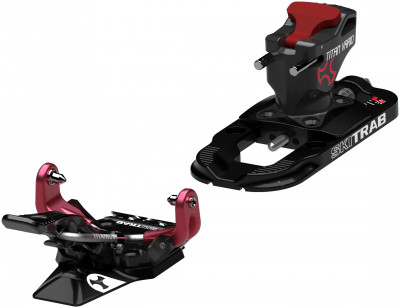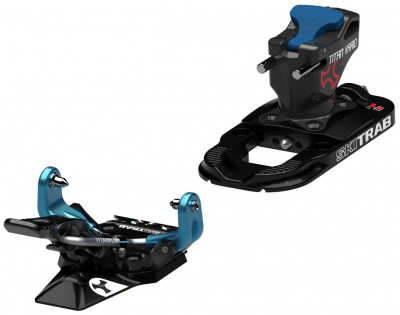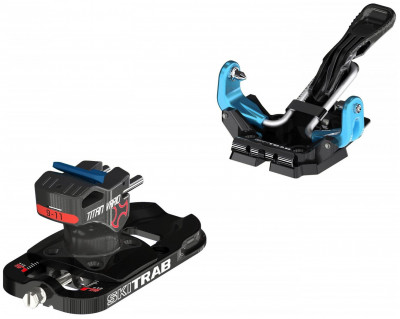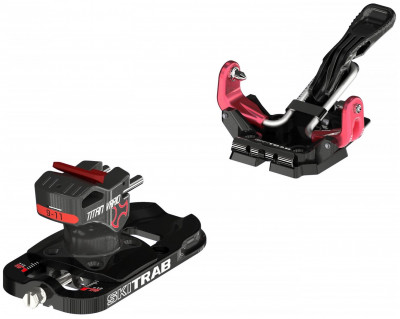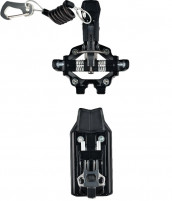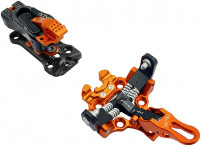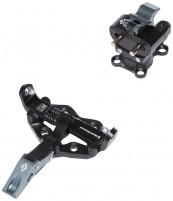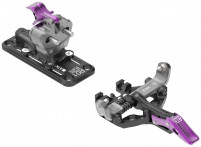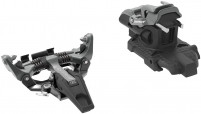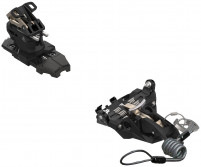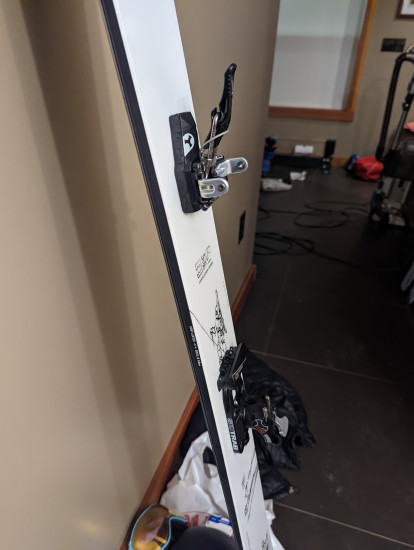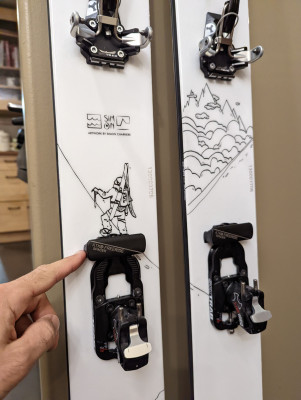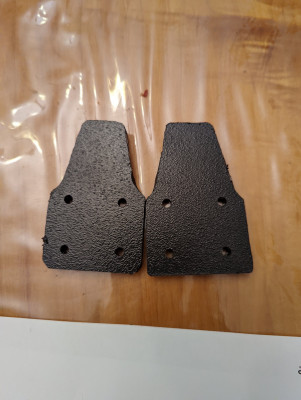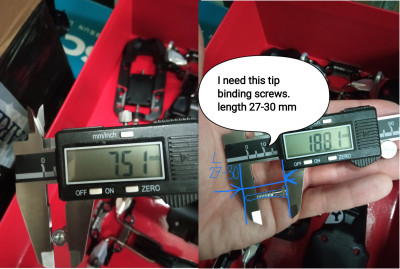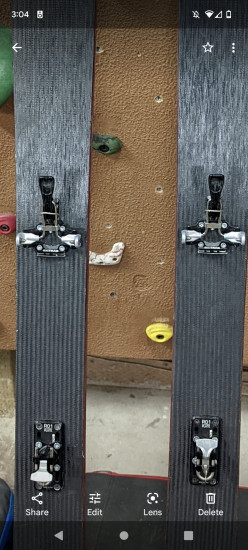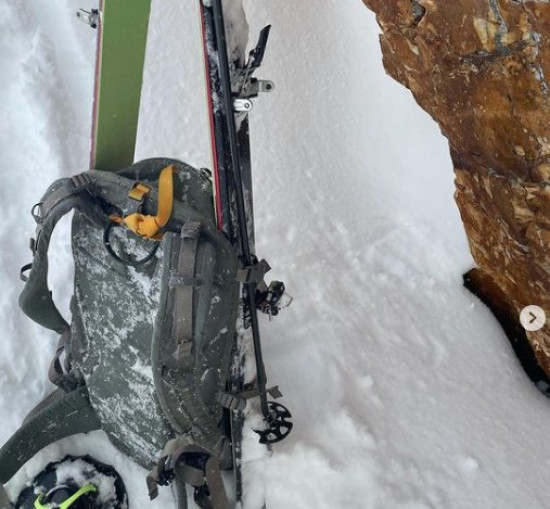Ski Trab Titan Vario.2 Binding
The original Ski Trab Titan Vario is spoken of in hushed and reverent tones here at Skimo Co, and the fact that many of our employees ski this binding for ~90% of their days each season is evidence of how much we liked the original version. If the original Titan Vario was the first Toy Story movie, then the Titan Vario.2 binding is Toy Story 2-- the rare sequel that lives up to the high standard set by the original. Since one pin can flex partially open without forcing the other side to open, the Titan toe pieces have an amazing retention profile. The heels received the lion's share of the makeover, and the now-gapless units are offered with three different fixed-release levels in the ranges of 5-7, 7-9, or 9-11. The housing rides on a spring which keep the release consistent, and the track this heel unit rides on is flexible in order to accommodate ski flex. The Vario.2 has a safety and performance profile heretofore unheard of in this category of lightweight bindings. Aside from an updated heel release mechanism, Ski Trab added a third riser that will be welcome on steep skin tracks or in deep snow-- just rotate the heel 180 degrees and voilà, the tall boy is ready to go. Making changes to a product that had such few flaws is a risky game, but in the case of the Ski Trab Titan Vario.2, the gamble paid off big time.
- A high-strength titanium spring in the toe provides independent clamping on each side, decreasing the chances of pre-release.
- A short and flexible heel plate keeps the alterations to the flex of the ski at a minimum, preserving safety as well as performance.
- First heel riser is a race-flap, making it quick to deploy while keeping a higher option available with a simple twist.
- A fast and simple ski crampon attachment point on the back of the toe unit will feel very familiar to avid backcountry skiers.
- Gapless heel pin design means the release values remain more consistent throughout the flex of the ski.
- The titanium spring in the toe piece is durable and simple, with fewer moving parts than a traditional tech toe piece.
- Elasticity in both the toe and heel pieces absorbs impact from bumps while offering superior retention characteristics.
- Optional brakes mounted under the heels feature an innovative anti-friction mechanism that won't interfere with the release.
- Stepping into the binding is the same as before-- just press down on the toe lever with your pole and step in.
- The heel plate has a spring inside of it, providing 8mm of elasticity to account for ski flex.
- Roto-riveted toe pins clean the snow and debris from your boot fittings while you skin.
- Turn the heel housing 90 degrees for a functional flat mode for those long approaches.
- With 24mm of heel adjustment along the plate, you can accommodate a quiver of boots.
- While not adjustable*, three spring strengths are available to accommodate most skiers.
* Contrary to what the listed ranges might imply, this binding does not have adjustable release settings. Uniquely, Ski Trab provides a range of skier chart values that each fixed-spring set is targeting (both the internal lateral springs and the replaceable vertical U-springs vary in tension). The release has been testing towards the high end of the range, so round down if you're on the border (e.g. choose 7-9 if you're a 9).
Update 2022/23: Ski Trab added an anodized red option so your bindings can reflect your emotion when someone boots in the skin track.
| Specifications | |
|
Weight |
254g [7-9] |
| Weight (pair) | 508g [7-9] |
|
Boot |
Tech |
|
Brakes |
Accessory 78, 85, 94 |
|
BSL |
24mm |
|
Riser |
2 + Flat |
|
Vertical |
5-7, 7-9 or 9-11 |
|
Lateral |
5-7, 7-9 or 9-11 |
|
Crampon |
Included Option |
| Specs Verified | Yes |
| Design | |
|
|
Titanium toe bar, Ergal aluminum frame, steel pins |
| Skimo Co Says | |
| Usage | Ski touring, training, mountaineering |
| Notes | Gapless heel keeps the release consistent while the ski is flexing |
| Bottom Line | Unmatched combo of performance, retention, and weight |
| Compare to other Lean Bindings | |
Related Products
Questions & Reviews
Although not an item that we stock, the U-spring in the Ski Trab Titan Vario.2 can be changed out. However, that will only affect the vertical release value of the binding. In order to change out the lateral release value, you will need to get new heel pieces. You can find Vario.2 heels under our Ski Trab Heel Pieces listing.
Ski Trab makes the best bindings on the market. This is a simple fact due to the lateral elasticity in the heel piece and the unique toe design. But I want to call attention to the absolute tragedy that is the discontinuation of the Vario 1 which is a better binding for most ski tourers. The Vario 1, mounted flat on ski or with an ATK R01 plate offers nearly identical performance with less ramp angle and ~100g less weight per ski. I personally prefer a 5mm binding delta which is achievable by using the Vario 1 with the ATK R01 plate, and cannot be had with the Vario2 without using a heavy toe shim from B&D or by making one yourself. Like Zach, I am unconvinced that the gapless heel design is worth the extra weight and bulk.
Ski Trab - I hope you're reading this. Why are you depriving us of what is essentially the perfect binding? Please make the Vario 1 again!
The only benefit I see for the Vario.2 heel is that it is perhaps safer with a consistent release from the gapless setup. Personally, I found the purported "downhill elasticity" to be a mirage, or at the very least well overrated. I didn't detect *any* elasticity benefit on the downhill.
Therefore, you have to determine whether gapless release is worth 130g per binding. Otherwise, get a Gara Titan or the Vario 1 (if you can find it). To me, it's not worthwhile. There are a lot of other features you can add in the 250g range. I already find most of those to be not worth the weight, and the gapless release falls in the same category for me. I'm generally skeptical of tech binding release: whether your purported, non-standard release value is an 8 or a 9, whether your ski flexed x mm instead of y so the torque needed to pop out was a or b, whether your preferred lateral release value is different than your preferred vertical release value. The best strategy seems to be to simply not crash.
And add on other deficiencies with the heel: so much plastic - not confidence inspiring, an oddly high default riser height (51mm vs the typical 35-40mm of most race bindings). It's not worthy of the hype imo.
Sorry to the lightweight ski touring community - I am a naysayer. I skied these 5-7 times then sold them.
The Vario.2 with a stopper installed does not quite have a flat mode. The lowest you can go is resting atop the lever that flips in front of the heel piece when retracting the brake arms. The first riser can be accessed with the pins facing forward, and the higher riser can be accessed by turning the heel 180 degrees. Feel free to reach out to us at help@skimo.co with any further questions!
Unfortunately, Ski Trab does not make a brake wider than 94mm for the Vario.2. Brakes can often be bent to accommodate a wider ski, but bending from 94mm to 106mm would not work. Feel free to reach out to help@skimo.co for other solutions!
I find the toe works better than an ATK toe as far as snow packing issues. However after a long day I find them a bit difficult to remove due to the spring strength.
The heels are great, but if using without the brakes you need an extra piece(spacer) so the adjustment track operates correctly.
I love the brakes and how I can still do a one motion transition with them, unlike the ATK heel brakes. However I do notice some snow packing into the space between the heel and the brakes a few times now which has required some work to remove.
But, how can the best improve?
A) it's a little fat on the lean side. I think a lot more weight loss can occur in the heel area while keeping it gapless. Perhaps even lowering the track from 8mm to 4mm like the marker alpinist? Would be curious to see how much travel is used or necessary during intense loading.
B) lotta plastic. More TI plz.
C) high heel ramp. 8.5mm. ouch.
D) would be improved by having independent pins like the freeraider. More durability, release and serviceability options.
E) freeride spacer-SO HAWT RIGHT NOW.
F) I like the brake design, but 94mm as the max???? Fortunately I don't use brakes, but they aren't wide enough for any sidecountry ski I want to take into that terrain even if the binder can easily handle it.
So I took it upon myself to upgrayyyyd the Vario 2.0 into the Vario 2.69420.
The Vario 2.69420 comes complete with freeride spacer for maximum sendage and "for your pleasure" skiing. I also decided that skiing in high heels is ridiculous so I didn't settle for a low heel ramp angle...I gave the Vario 2.69420 a POSITIVE +2, ramp angle for max biomechanical efficiency and a more upright balance point for my long ass femurs and tibias. This involved a jigsaw, Dremel, ABS block of plastic, Christmas story type dad cursing, and about 30 minutes of grinding long screws down to fit into the trabs.
We shall see if trab adopts any of these suggestions for the 3.0. until then the Vario 2.69420 may be the hottest binding of 2040. The future is now.
How do you rate those Fraction skis? Valid answers are either 69/420 or 420/69 stars.
The only *complaint* really isn't one: the toe pieces aren't step in. Recommend practicing before you need to step in on a knife-edge...
These are worth the coin without question.
Thanks
In version 1 I have had an issue where the plate moves out throughout the day and eventually I have to re-adjust if I don't come out of the binding first. I tried one warranty replacement but the issue persisted, and has not been resolved. Basically the adjustment screw is finger tight and not tight enough to resist vibrating out.
The Ski Trab Titan Vario Adjustable and Ski Trab Titan Vario.2 are mounted on the same adjustment track. I ski both the Titan Vario Adjustable, as well as the Titan Vario.2. Huge fan of how these bindings ski as well as their retention characteristics.
I am sorry to hear that you have had issues with the adjustment track on your Ski Trab Titan Vario Adjustable Bindings. If you need to help brainstorming any other solutions, please reach out to us at help@skimo.co.
I want to put them on Ski Trab Maximos with the intent of using the ski for 60% of Wasatch days (other skis are race, mountaineering, and deep pow).
One worry with the Crest is that my ski partner has Crests and the heel pieces and risers are pretty fiddly. We stop on the skintrack most tours because the heels have rotated or the riser is doing something weird. I won't call him out by name because he'll probably see this question anyways :)
Toe unit: 18mm flathead M5, with the heads ground to 7mm diameter
Heel unit: 12mm lowhead M5, no mods needed
I'm working on my set of 18mm flatheads ground to 7mm right now and I'll post back after a lot of testing. I did something similar with G3 Zed toes that needed 10mm flatheads ground to 8mm diameter heads and it worked great.
** I'm not an expert at this, just an avid hobbyist. Always defer to what skimo.co techs say.
The way to connect and disconnect to the toepiece is unique and takes some getting used to, especially in technical terrain. That's the reason I fell into the rocks. I want to take some more time to get used to it before saying it's a bad thing. It's just different.
Earn store credit by writing reviews. Learn more.






